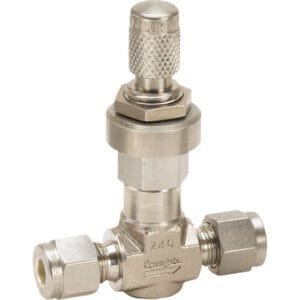Swagelok VCR Adapter Fittings: High-Purity Sealing Solutions for UHV and Specialty Gas Systems
Swagelok VCR Adapter Fittings from TFM deliver uncompromising performance in low-pressure gas and ultra-high vacuum (UHV) systems. Featuring a metal gasket face-seal design, these adapters provide leak-tight, particle-free connections ideal for helium leak checks, lecture bottle setups, cleanroom installations, and bakeable gas systems.
Swagelok VCR adapters are engineered to seamlessly integrate VCR face-seal connections with a variety of fitting terminations, including male/female NPT, weld ends, or tube stub outs, offering system designers the flexibility to connect VCR fittings to virtually any port or component.
Key Features of Swagelok VCR Adapter Fittings:
Superior Sealing for Low-Pressure Gas Systems
VCR adapters create robust, metal-to-metal face seals, ensuring zero elastomer degradation and long-term leak-tight connections, even under thermal cycling.High-Temperature Compatibility
With stainless steel gaskets, Swagelok VCR fittings can withstand bakeout temperatures up to 538°C, ideal for UHV and semiconductor-grade systems.
With copper gaskets, they maintain tight seals at up to 204°C, offering reliable performance in standard industrial gas plumbing.
Ultra-High Vacuum (UHV) Performance
Designed for environments down to 10⁻⁹ Torr or lower, these fittings are fully compatible with UHV chambers, leak detection systems, and mass spectrometry interfaces.Versatile Connection Options
TFM’s Swagelok VCR Adapter Fittings are available in a range of terminations, such as:VCR male to female NPT
VCR female to weld stub
VCR male to Swagelok compression
VCR female to KF/CF vacuum flanges
Cleanroom and Semiconductor-Ready
All VCR adapters are machined from 316L stainless steel with surface finishes suitable for high-purity gas delivery systems and corrosive applications.
Applications:
“Lecture bottle” gas cylinder connections
Helium leak detection interfaces
Plasma etch and deposition tool gas inlets
High-temperature and UHV-compatible glovebox setups
Gas distribution panels in semiconductor cleanrooms
Analytical instrumentation, including GC/MS and RGA systems
TFM also supplies a wide range of Swagelok-compatible VCR accessories, including gaskets (stainless steel or copper), nuts, caps, and face-seal glands, providing a complete solution for every stage of system integration and maintenance.
Ordering Table
| Material | Tube OD 1 | Tube OD 2 | Part Number |
| Stainless Steel | 0.125 | 0.25 | 2MVCR-4FVCR |
| Stainless Steel | 0.25 | 0.5 | 4MVCR-8FVCR |





Reviews
There are no reviews yet.